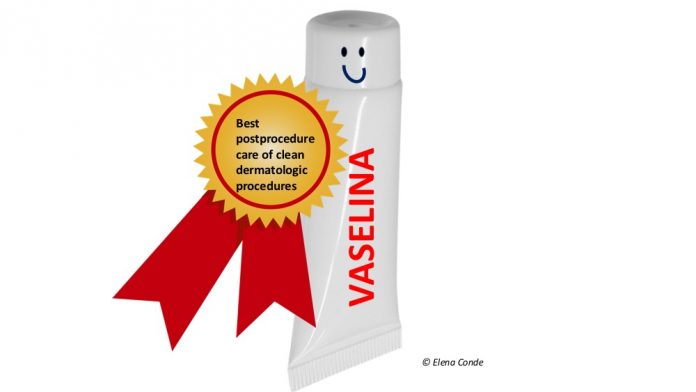
Dermatology is a specialty in which we perform daily invasive processes (cryotherapy, laser, electrocoagulation, biopsies, extirpations), with the consequent production of wounds that are considered clean lesions. If we analyse our daily clinical practice, type of dressing changes until complete re-epithelialization is very variable. A wide variety of recommendations may be found, such as cleansing with soap and water, chlorhexidine or povidone iodine, antibiotic ointment, vaseline products, occlusive dressings…
The use of antiseptics or antibiotics to prevent wound infection seems to give us peace of mind (Nijhawan, 2013). Many professionals recommend the use of topical antibiotics since their presentation in ointment favours healing in a moist environment. However, the use of these products in a prophylactic way is not indicated after dermatological clean invasive procedures (Levender, 2012).
The incidence of complications in dermatological surgery is very low, varying in the studies from 0.07 to 4.25% (Rogers, 2010; Lee, 2015). The use of antiseptics in dressing changes after these clean procedures does not represent a benefit and may be harmful in the healing process due to their cytotoxicity (Cho, 1998). On the other hand, the indiscriminate use of topical antibiotics, in addition to not having shown a benefit in reducing infection rates, contributes to the development of antibiotic resistance and the onset of contact dermatitis (Gehrig, 2008), with an increase in healthcare costs.
Topical vaseline products would represent a safe treatment option as they promote healing in a moist environment without the aforementioned inconveniences.
Different clinical trials and a systematic review have been carried out with the aim of determining the efficacy of antibiotic ointments, in comparison with vaseline, in the prevention of infection of clean surgical wounds (Saco, 2014; Lee,2015). Among the results and conclusions of these studies, the recommendation of the use of vaseline, and not antibiotic ointments, stands out for healing of clean wounds after dermatological procedures. The application of vaseline would not be necessary in cases where occlusive dressings are used, since no statistically significant differences have been found on the risk of infection and the final result between adding or not adding ointments (vaseline alone or with antibiotic) under them (Dixon, 2006). However, the use of occlusive dressings implies a higher expense than the use of vaseline ointment and an adhesive dressing with gauze, and no significant benefit has been demonstrated from their use in this type of wounds (Ubbink, 2008).
What do you recommend? What is your experience?
References:
Cho CY1, Lo JS. Dressing the part. Dermatol Clin. 1998 Jan;16(1):25-47.




